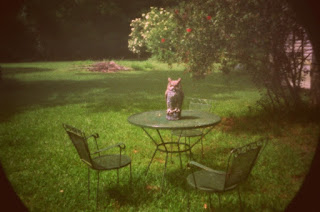The Holga HPL-P is simply a pinhole mounted in a Pentax
K-Mount lens barrel instead of an actual lens. The whole thing is plastic (like
all things Holga) and looks very much like the Holga HL-P which is simply a plastic
Holga lens mounted in a plastic K-Mount lens barrel.
As you can see from the image above there is a pronounced vignette
effect in all four corners. This is the result of being designed for an APS-C crop
frame digital sensor rather than the full frame negative of a 35mm SLR which is
what I used to shoot this picture. Still, the image is not too shabby and does
display the usual “look.” All I did in the way of post processing was brighten the
colors of the scan up a little in Picasa.
The greatest challenge to using this gadget (I really can’t
call it a lens now can I?) was trying to see anything in the viewfinder of the
SLR. It was mostly dark as a result of the tiny aperture. In spite of extensive
research (even reading the instructions that came with the HPL-P) I was unable
to find any definitive information on the thing except that it has a .25mm
diameter pinhole. Based on that and some empirical data from the exposure
values of the pictures taken I have estimated the aperture to be about f133.
The image above was taken using my Pentax ZX-L loaded with a
roll of CVS 400 color film at a ½ second shutter speed.
Frankly, I am a little disappointed with this “pinhole lens.”
I had hoped it could be used with a 35mm camera and that the image would be as
good at least as my Home-made cardboard pinhole camera but I believe the
pictures from the latter are much better than the former.
Next I will try it on a DSLR with a crop frame sensor and
see what happens.




